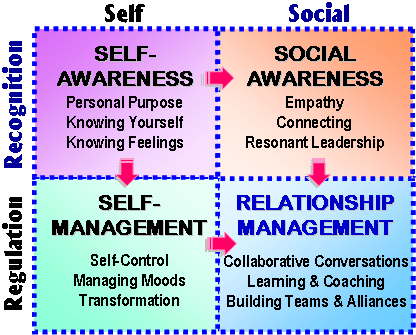Teachers Make Other Students Peer Review Each Others Work So They Dont Have to

Perhaps you lot may have heard that what is even more important than a person's 'IQ' is their 'EQ', or emotional intelligence, and are interested in learning more.
Broadly speaking, emotional intelligence involves the chapters to sympathise and manage emotion. Yet, can this be measured?
IQ tests are well-known assessments of cognitive capacity, however, tests of emotional intelligence are more complicated. At that place are many free quizzes readily available to examination EQ, but every bit is explained shortly, such self-report measures are not always accurate.
Ability tests of EQ fare ameliorate. The post-obit article explores the 'ins and outs' of emotional intelligence testing. Along with a rich assortment of information, this article volition also provide links to some gratis EQ assessments and samples of questions so that yous can really get a feel for EQ tests.
I hope information technology sparks your interest!
Before you read on, we idea you might like to download our 3 Emotional Intelligence Exercises for free. These scientific discipline-based exercises volition not merely heighten your ability to empathise and manage your emotions but will besides requite yous the tools to help foster the emotional intelligence of your clients, students or employees.
What is an Emotional Intelligence Test?
And so, just what is a exam of emotional intelligence?
Well, put but, as opposed to a self-report scale of EI, an EI test is developed differently. You meet, EI tests are based on the premise that EI consists of a grouping of skills that are employed in order to solve emotional problems.
Therefore, equally explained by pioneers in the inquiry area of EI, Mayer, Caruso, Salovey & Sitarenios (2003), considering it is developed from a skill-base, that EI is, therefore, a singled-out ability that can be measured objectively.
What is an EQ appraisal?
 Another manner of looking at the cess of EI is an EQ appraisement.
Another manner of looking at the cess of EI is an EQ appraisement.
One example of an EQ appraisement is the Emotional Intelligence Appraisement that features in the best-selling work 'Emotional Intelligence 2.0' (Bradberry & Su, 2006).
The appraisement was created in 2001 by Dr. Travis Bradberry and Dr. Jean Greaves and information technology may be administered in either online form or in a booklet. You can find more emotional intelligence books hither.
The EQ appraisal is a skill-based assessment based on Daniel Goleman'southward four-gene taxonomy (Bradberry & Su, 2006). Co-ordinate to Goleman, EI consists of iv components:
- self-sensation,
- self-direction,
- social awareness and
- human relationship management.
The EQ appraisal consists of 28 items and is performance based – information technology is designed to assess the behavior linked to EI skills. The assessment gives an overall EQ score, and a score for each of the iv EI factors (Bradberry & Su, 2006).
Research with The Emotional Intelligence Appraisal has found Cronbach alpha reliability ratings between .85 and .91 however, interestingly, a non-significant positive correlation was plant between the appraisal and the popular EI test, the Mayer-Salovey-Caruso Emotional Intelligence Test.
In the post-obit sections of this article, you can certainly read more about the MSCEIT. Briefly, however, for the purpose of an introduction to this discussion, the MSCEIT is an ability model of EI.
Researchers take suggested that there is a stardom between the constructs that are measured by the MSCEIT and EI Appraisal (Bradberry & Su, 2006). It was reasoned that this difference in models from which the assessments were adult – the MSCEIT is an ability-based assessment, whereas the EI Appraisal was based on Daniel Goleman'south 'mixed' model of EI.
It has been claimed that scores on the Emotional Intelligence Appraisal predicted task operation more than than the MSCEIT, and what'due south more, it also takes one-5th of the length of fourth dimension to administer.
The Emotional Intelligence 2.0 Examination
In this section of the article, I will be focusing on the Mayer-Salovey-Caruso Emotional Intelligence Exam, Version 2.0 (MSCEIT, V two.0). The MSCEIT is a 141 calibration that measures the 4 branches of EI, each co-operative reflecting specific skills – perceiving emotions, using emotions to facilitate idea, understanding emotions and managing emotions (Mayer, Caruso, Salovey & Sitarenios, 2003).
Each of these 4 'branches' is measured in the MSCEIT using two tasks, as described below:
Branch one – perceiving emotions: faces and pictures tasks
Branch 2 – facilitating thought: sensations and facilitation tasks
Branch three – agreement emotions: blends and changes tasks
Branch four – managing emotions: emotion management and emotional relationships tasks.
Each of these 8 tasks is measured either by a detached, unmarried item or a grouping of individual items that make upwards an 'item parcel' (Mayer et al., 2003). Detail parcels are collections of related items – so, for case, the 'faces task' consists of four item parcels, each containing five responses. Some items just require one response per stimulus so are distinct and free-standing (Mayer et al., 2003).
Across the 8 tasks, the responses required take different forms. The exam was designed this fashion so that the results beyond the response methods can be generalized, and likewise minimize the associated error in measurement (Mayer et al., 2003). So, some tasks use a 5-signal rating scale, whereas others require a multiple-option response.
Let'south wait at this examination a petty closer…
The 'faces' job is made up of 4 item parcels, each with 5 responses (Mayer et al., 2003). In this task, participants are presented with a group of faces, and they are required to answer with the specific emotion they can identify as portrayed in the face (Mayer et al., 2003).
The 'pictures' task consists of 6 parcels each with 5 responses. Information technology is like to the 'faces' task, except that the target stimuli are abstract designs and landscapes, and to reply, participants select from cartoon faces that show specific emotions (Mayer et al., 2003).
The 'sensations' task consists of v parcels, each with iii responses. Participants match sensations to the emotions they generate – e.1000. describing how 'hot' or 'common cold' a feeling of envy is (Mayer et al., 2003).
The 'facilitation' chore is made up of v detail parcels, each with iii responses. This task requires a decision virtually the moods that are most closely associated with specific behaviors and cognitive tasks, in terms of accompanying them or assisting them. The example given by Mayer, Caruso, Salovey, and Sitanerios (2003) is "whether joy may assist planning a party" (p. 99).
The 'blends' job consists of 12 gratis-standing items. Responders choose which emotions could be combined to produce another emotion – for example, that malice could be formed past combining envy and assailment (Mayer et al., 2003).
The 'changes' chore is fabricated up of xx free-continuing items in which individuals cull the emotion that emerges due to another emotion intensifying – east.g. that depression is almost likely to result from intensification of sadness and fatigue (Mayer et al., 2003).
The 'emotion direction' task consists of 5 parcels, each with iv responses. In this task, responders are required to class a judgment nearly the all-time actions that tin be taken by an individual in a story in gild to result in the specified emotional issue (Mayer et al., 2003).
So, for instance, the participant might read a story virtually a character and need to identify what this graphic symbol tin do to reduce their anger or prolong joy (Mayer et al., 2003).
Finally, the 'emotional human relationship' task. This task is made up of 3 particular parcels, each with 3 responses. This task requires test-takers to decide what are the most effective actions an private tin take in order to manage another person's feelings (Mayer et al., 2003).
Putting this all together, it can be seen that the MSCEIT 2.0 is a comprehensive exam of EI. In fact, it requires a total of 705 responses – 141 items are included, each with 5 responses (Mayer et al., 2003).
Can EI Actually be Measured With a Quiz?
 According to Matthews, Roberts, and Zeidner (2004), there are a number of bug and serious omissions in the surface area of EI as measured by a uncomplicated self-written report cess.
According to Matthews, Roberts, and Zeidner (2004), there are a number of bug and serious omissions in the surface area of EI as measured by a uncomplicated self-written report cess.
In actual fact, this issue is what led Mayer, Caruso, and Salovey to fence that performance-based measures are needed for EI to be understood as an actual cerebral ability (Matthews, Roberts & Zeidner, 2004).
Their argument and then resulted in the development of the Multi-Factor Emotional Intelligence Scale (the MEIS) and, more than recently, the MSCEIT.
To consider EI as a scientific construct, it is necessary to determine whether EI is a measurable phenomenon (Matthews et al., 2004). Self-report measures of EI have shown satisfactory internal consistency reliably across a multifariousness of cultures, as well as more than adequate levels of examination-retest reliability over 1 – and 4-month periods (Matthews et al., 2004).
On the other hand, performance-based measures of EI have been shown to present a number of problems in terms of reliability (Matthews et al., 2004). All these issues seem to suggest that EI may non be able to be measured.
Indeed. Whether or not EI tests actually measure a theoretical construct or trait is termed 'construct validity', and, in actual fact, Matthews and colleagues (2004) concluded that neither functioning-based or self-report measures of EI meet the criteria for what is deemed 'construct validity'.
However, past inquiry has constitute a relatively minor association betwixt self-written report measures of EI and actual ability measures (Matthews et al., 2004). What a complicated picture EI presents! What are we to make of these claims?
Well, further inquiry into the measurement of EI is certainly warranted – specially into validation studies of self-report measures of EI. According to Matthews et al (2004), "at that place are major conceptual, psychometric, and applied bug and issues to be overcome before EI can be considered a genuine, scientifically validated construct with real-life practical significance" (p. 192).
Other research, nevertheless, argues against what Matthews and colleagues presented in the 2004 paper titled 'Seven myths about emotional intelligence'. It does in bodily fact support the notion that EI tin can be readily measured using tests, particularity self-report tests.
Withal, just considering something is easily measured this does non mean that such measures are authentic.
The fact that EI is made up of a range of skills does hateful that self-report is not the most authentic manner to measure EI (Matthews et al., 2004). This as well ways, even so, that fifty-fifty though self-report measures are not constructive measures of EI, that because EI consists of a range of skills and abilities, in a like vein to the measurement of other skills, these skills can be measured!
In other words, yes, EI power tests are legitimate measures of EI.
What's in an Emotional Intelligence Questionnaire?
To show what to await from an EI questionnaire, I will now provide an example of an EI-quiz (Mind Tools, 2019). In this quiz, xv statements are presented and responders are asked to reply as to how they actually are, rather than how they retrieve they should exist:
- I can recognize my emotions equally I experience them
- I lose my temper when I feel frustrated
- People accept told me that I'm a good listener
- I know how to calm myself down when I feel anxious or upset
- I relish organizing groups
- I detect it hard to focus on something over the long term
- I find information technology difficult to move on when I feel frustrated or unhappy
- I know my strengths and weaknesses
- I avoid conflict and negotiations
- I feel that I don't relish my work
- I ask people for feedback on what I practice well, and how I can better
- I set long-term goals and review my progress regularly
- I find it difficult to read other people's emotions
- I struggle to build rapport with others
- I utilize active listening skills when people speak to me
For each of these statements, the responders would rate themselves from not at all, rarely, sometimes, often and very often (Mind Tools, 2019).
How is EI Measured?
 Generally speaking, EI is measured in three dissimilar ways:
Generally speaking, EI is measured in three dissimilar ways:
- Cocky-report
- Other-report
- Ability measures
A variety of scales, quizzes and questionnaires accept been adult for each of these methods of measuring EI. At that place are four full general types of EI tests, which are described in more detail presently!
- Abilities based tests (including the MSCEIT)
- Trait-based tests (such as the Bar-On EQi)
- Competency-based tests – (including the ESCI)
- Behavior-based tests – (for instance, the Genos)
Whilst all provide measures of EI, for situations where an accurate, objective cess of EI is wanted (such every bit recruitment) the consensus from the research is to use the MSCEIT (Bradberry, 2014).
The Emotional Intelligence Calibration
Schutte and colleagues (1998) developed a measure of emotional intelligence based on the model that was published past Salovey and Mayer in 1990. Threescore-two items were plant to be cogitating of the dimensions of Salovey and Mayer'south model (Schutte, Malouff, Hall, Haggerty, Cooper, Gold, & Dornheim, 1998).
And then, a cistron analysis of results from a study of 346 participants lead to the development of this 33-particular calibration:
- I know when to speak about my personal problems to others
- When I am faced with obstacles, I retrieve times I faced similar obstacles and overcame them
- I expect that I will do well on most things I try
- Other people find it easy to confide in me
- I find it hard to understand the non-verbal letters of other people*
- Some of the major events of my life have led me to re-evaluate what is important and not important
- When my mood changes, I see new possibilities
- Emotions are one of the things that make my life worth living
- I am enlightened of my emotions as I experience them
- I wait good things to happen
- I like to share my emotions with others
- When I feel a positive emotion, I know how to make information technology concluding
- I arrange events others enjoy
- I seek out activities that make me happy
- I am aware of the non-verbal messages I send to others
- I present myself in a way that makes a good impression on others
- When I am in a positive mood, solving problems is easy for me
- Past looking at their facial expressions, I recognize the emotions people are experiencing
- I know why my emotions change
- When I am in a positive mood, I am able to come up up with new ideas
- I have command over my emotions
- I easily recognize my emotions as I feel them
- I motivate myself by imagining a good outcome to tasks I take on
- I compliment others when they have done something well
- I am aware of the non-verbal messages other people transport
- When another person tells me nigh an of import event in his or her life, I almost feel as though I have experienced this result myself
- When I feel a change in emotions, I tend to come up with new ideas
- When I am faced with a challenge, I give up considering I believe I will neglect*
- I know what other people are feeling just past looking at them
- I help other people feel better when they are down
- I use good moods to help myself keep trying in the face of obstacles
- I can tell how people are feeling by listening to the tone of their vocalization
- Information technology is difficult for me to understand why people feel the way they do*
Further studies of this 33 – particular measure found information technology to take good internal consistency and test-retest reliability.
four Case Emotional Intelligence Tests and Questions
 Are you now curious about EI tests? Perhaps the following clarification of four examples of EI tests can capture your interest!
Are you now curious about EI tests? Perhaps the following clarification of four examples of EI tests can capture your interest!
1. The Emotional Quotient Inventory 2.0 (EQ-i-2.0)
This test was the first scientifically validated, and now the nearly extensively used, EI cess worldwide (Australian Council for Educational Research, 2016).
It was developed from 20 years of global inquiry. The EQ-i is a self-report measure for individuals anile 16 years and older and can be delivered online. It takes approximately 30 minutes, and participants are required to respond to questions designed to assess key aspects of emotional skills related to life and workplace operation.
Such skills have been shown to affect operation in complex areas such equally disharmonize resolution and planning (ACER, 2016).
The results from the EQ-i tin provide respondents with data well-nigh emotional skills they tin can improve as well every bit those areas that they excel in – which can so pb to individuals having the capacity to utilize their strengths to maximize performance in daily tasks (ACER, 2016).
The EQ-i 2.0 is administered from an online portal that achieves simple and efficient administration, scoring and reporting.
One time an individual completes the test, a report is produced that takes the form of an inventory. The inventory includes 15 competencies that centre around 5 composite areas of EI – cocky-perception, self-expression, interpersonal, decision-making and stress management (ACER, 2016).
Although taking the examination is gratuitous, in order to administrate the test a practitioner must meet the requirements of the EQ-i qualification level.
The EQ-i is based on Bar-On'due south model of emotional-social intelligence, and information technology is accompanied past the EQ-360 (Consortium for Research on Emotional Intelligence in Organizations – CREIO, 2018).
The EQ-360 provides a more than comprehensive analysis of EQ considering information technology also includes information provided by others. Observer ratings are and so considered in conjunction with the results of an EQ-i-two.0 self-written report to give a more detailed contour (CREIO, 2018).
2. Profile of Emotional Competence (PEC)
This test was adult by Brasseur & Mikolajczak and provides separate measures of intra-personal EI and inter-personal EI (CREIO, 2018). It looks at 5 cadre emotional competencies – identification, understanding, expression, regulation, and use of emotions – in the self and others.
Information technology has been extensively validated in research, with results taken from a total sample of almost 22 000 individuals (CREIO, 2018). It is available gratis of charge for research and clinical purposes.
The total PEC consists of 50 items and takes approximately ane- xv minutes to administer, and the brusque form includes 20 items and takes 5 – ten minutes to consummate. The PEC is a self-study measure, however, information technology needs to be administered by a psychologist who is familiar with the emotional intelligence and emotional competence inquiry and theory (CREIO, 2018).
iii. The Trait Emotional Intelligence Questionnaire (TEIQue)
The TEIQue was developed by Dr. M. V. Petrides and is available free of accuse for academic and clinical research (CREIO, 2018).
The full-course consists of 153 items, measuring 15 distinct facets, 4 factors and global trait EI. The short-course is a thirty-item examination that measures global trait EI which was adult from the total-form TEIQue (CREIO, 2018).
Based on correlations with corresponding full facet scores, 2 items were selected for inclusion from each of the xv facets of the full-form TEIQue.
This questionnaire is also presented to gather ratings from observers – the TEIQue 360° and 360° Brusk-grade (CREIO, 2018). Dr. Stella Mavroveli likewise designed the TEIQue Child-form that is suited to children aged viii – 12 years.
This questionnaire consists of 75 items which are responded to on a five-betoken scale and looks at the 9 distinct facets of trait EI in children (CREIO, 2018).
4. Wong's Emotional Intelligence Scale (WEIS)
This is a self-report measure out of EI designed to be used by Chinese respondents (CREIO, 2018). It is based on the four ability dimensions mentioned previously that make upwardly EI. It consists of ii parts:
- The first part includes xx scenarios. Respondents choose the pick that most closely reflects the reaction they are probable to have in each scenario that is described (CREIO, 2018)
- The second part is fabricated up of twenty ability pairs. Respondents are required to select one of ii types of abilities that best demonstrates their force (CREIO, 2018).
At present that nosotros have looked at EI tests, let's consider the types of questions that announced in these assessments. The post-obit questions, from the PEC (Contour of Emotional Competence), are similar to those used in a variety of EI tests.
Hopefully they can provide you with an thought of what it may exist similar to practise an EQ test!
Sample Questions (accessed from CREIO, 2018):
- Equally my emotions arise I don't know where they came from
- I don't always understand why I respond in the manner I do
- If I wanted, I could hands influence other people's emotions to achieve what I want
- I know what to practise to win people over to my crusade
- When I feel good, I can easily tell whether it is due to being proud of myself, happy or relaxed
- I am adept at describing my feelings
- I can easily get what I want from others
- I hands manage to calm myself down after a difficult experience
- Most of the fourth dimension I understand why people feel the way they do
- When I am pitiful, I find information technology easy to cheer myself upward
- I find it difficult to handle my emotions
- When I am angry, I find information technology easy to calm myself down
- I am often surprised by people's responses because I was not aware they were in a bad mood
- My feelings help me to focus on what is important to me
- Others don't accept the way I limited my emotions
- When I am sad, I often don't know why
- In a stressful situation I usually think in a manner that helps me stay calm
Are There 'Correct Answers' to EQ Assessments?
In fact, yes, there are so-chosen 'correct answers' to EQ assessments – however, this only applies to the objective measures of EQ… obviously, there is no such thing as a 'correct' answer in a self-report cess!
Research has included efficacious means to place 'right' alternatives in EQ tests– e.g. in facial perception, or meanings of emotions terms (Mayer et al., 2003). This has been claimed due to the convergence between adept and general consensus on EI measures (Mayer et al., 2003). So-chosen 'right answers' are based on criteria developed from inquiry (Mayer et al., 2003).
What Does an EQ Score Mean?
 EQ is an emotional quotient score.
EQ is an emotional quotient score.
It is found by assessing the behavioral factors that reverberate EI.
For case, the EQ score reflects the way in which a person reacts in a variety of situations, including:
- Stressful or frustrating situations
- Failures, or disappointing situations
- Positions of leadership
- How an individual manages the emotions of people of a range of different ages, and
- Handling diversity and cultural sensitivities (My Frameworks, 2017).
EQ distinguishes emotional capacity as a distinct blazon of intellect. The average EQ score is in the range of xc – 100, whilst the perfect EQ score is 160. What does an EQ score really mean? Well, as well as contributing to success, EQ plays a part in everyday life (My Frameworks, 2017).
Six EQ Cocky-assessments
Maybe y'all are interested in testing your own EQ? Listed below are 6 readily available EQ self-assessments:
- Emotional Intelligence Test (2019). Psychology Today. Admission here.
- Test your East.I: Costless EQ quiz (2018). Establish for Health and Human Potential. Access here.
- How Emotionally Intelligent are Yous? Boosting Your People Skills (2019). Mind Tools. Access here.
- Emotional Intelligence Test (2019). Psych Tests. Admission hither.
- Emotional Intelligence Test Free – EQ Exam Gratis Online (2019). Blastoff High IQ Club. Access here.
- How Emotionally Intelligent Are You? (2017). My Frameworks. Access here.
Measuring Emotional Intelligence in the Workplace
 EI is closely associated with success in the workplace (Bradberry, 2014).
EI is closely associated with success in the workplace (Bradberry, 2014).
TalentSmart, a worldwide leader in the provision of emotional intelligence, examined EI aslope 33 other key workplace skills. It was discovered that EI was, in this case, the strongest predictor of performance (Bradberry, 2014). Actually, EI explained 58% of success in all job types!
How, then, is EI measured in the workplace?
The Consortium for Research on Emotional Intelligence in Organizations (CREIO) have reviewed a number of tests that promise to mensurate EI in workplace settings, and have selected those for which there is a substantial body of research. Let'south examine these different measures.
The Emotional and Social Competence Inventory (ESCI)
This is used to measure out EI and enables workplaces to raise awareness of EI based on feedback (CREIO, 2018).
A multi-rater assessment, this test also encourages the coaching and development of crucial work capabilities. It takes approximately thirty – 45 minutes to administer.
It looks at the following competency scales:
- emotional self-sensation,
- emotional self-control,
- adjustability,
- achievement orientation,
- positive outlook,
- empathy,
- organizational awareness,
- coach and mentor,
- inspirational leadership,
- influence,
- disharmonize management and
- teamwork (CREIO, 2018).
The Emotional and Social Competence Inventory – University Edition
The ESCI-U provides universities with an emotional and social intelligence test at a much lower cost than the corporate version (CREIO, 2018).
Information technology assesses 14 key competencies – 5 emotional intelligence, 7 social intelligence, and 2 cognitive competencies. The multi-rater version is said to be the virtually well validated and widely used behavioral measure of emotional and social intelligence (CREIO, 2018).
It has been used in schools. colleges and universities, and is currently used at undergraduate, Masters and doctoral levels in a number of countries (CREIO, 2018).
The ESCI-U takes approximately xxx – 45 minutes to administrate.
The Genos Emotional Intelligence Inventory (Genos Due east.I).
This assessment was developed from a wide range of peer-reviewed research, is available in many languages and is used in approximately 500 multi-national companies (CREIO, 2018). It is delivered via an online survey system which is modern and responsive.
The Genos EI consists of 42 items and takes approximately 10 minutes to consummate. Although it is designed to be used in workplaces, it has been claimed that information technology is a valid assessment for individuals anile 17 – 75 years (CREIO, 2018).
It looks into half-dozen competencies that reverberate the skills and behavior that develop as a outcome of EI abilities:
- self-awareness,
- awareness of others,
- actuality,
- emotional reasoning,
- self-management and
- positive influence.
The Group Emotional Competence (GEC) Inventory
This assessment of EI in the workplace was adult from the work of Vanessa Druskat and Steven Wolff who accept led the awarding of emotional competence at the group level (CREIO, 2018).
Information technology provides a measure of 9 group norms that have been associated with team effectiveness. Also, this feedback can help groups to recognize their strengths and weaknesses, and therefore observe areas for comeback (CREIO, 2018).
The GEC Inventory contains 57 items that measure the nine dimension of grouping EI reported past Druskat and Wolff.
The Piece of work Group Emotional Intelligence Profile (WEIP)
This is a self-report measure out that looks at EI of individuals in teams.
Respondents cull from a seven-point reference format (from 1 – strongly disagree to 7 – strongly agree) to items that are designed to appoint them in a reflection of their own behavior. For example, "I am able to describe accurately the way others in my squad are feeling" (CREIO, 2018).
The WEIP is designed to expect at two dimensions of EI – the ability to deal with one'south ain emotions (which makes up calibration one, consisting of eighteen items) and, the ability to deal with others' emotions (this is measured in scale 2, which has 12 items) (CREIO, 2018).
Scales i and 2 are each comprised of 5 subscales. Team EI is discovered by calculating the average scores of the WEIP for all team members.
Equally you lot tin can see, whilst EI is crucial in a work environment, employers and leaders in team settings have a few options for assessments to choose from that measure EI.
Relevant: Emotional Intelligence and Leadership Effectiveness
The Queendom Emotional Intelligence Test
Queendom.com is a subsidiary of PsychTests AIM Inc, which is a high-tech psychometric company that produces a range of services and products based on an all-encompassing battery of psychological assessments (Queendom, 2019).
PsychTests AIM provides psychometric services and related products to a very diverse range of groups: recruiters, Hr professionals, business organisation owners, therapists, life coaches, athletic organizations, students, researchers, marketers, and even professors! (Queendom, 2019).
As such, Queendom has adult 'scientifically developed and validated tests and quizzes', including the Emotional Intelligence Test.
What is this exam?
Well, the Queendom EI Test consists of 341 questions and takes approximately 60 – 90 minutes to complete (Queendom, 2019). The questions take the type of self-assessment, situational, and image-based questions. A test specifically adult to measure EI, the Queendom EI Test includes cocky-written report and skill-testing components.
What does the test provide?
The Queendom EI Test provides an introduction to EI, an overall score, assesses a range of scales, and besides advice – tips that are tailored from an private's results.
The scales are every bit follows:
- Emotional competencies
This calibration measures the ability to identify ane's emotions, and beingness comfy with emotional expression and emotional situations or people who are emotional. The emotional competency calibration likewise examines emotional reflection, emotional regulation, and emotional integration (Queendom, 2019) - Social competencies
Looks at a person's adjustable social skills and social insight. It examines the area of conflict – by looking at a knowledge of conflict resolution and conflict resolution behavior. The social competency scale likewise looks at empathy, flexibility, and the ability to read body linguistic communication (Queendom, 2019). - Drive
The 'drive' calibration focuses on goal-setting, striving, self-motivation and self-awareness which are all a component of EI. - Stress direction
This calibration looks at coping skills, emotional selectivity (in terms of magnitude) and emotional selectivity (in regards to precision). Furthermore, the stress management scale measures resilience, adaptability, and contentment. It looks at an individual's positive mindset, their extreme rumination, and the congruence of their behavior co-ordinate to values (Queendom, 2019). - Self-regard
The self-regard scale measures the aspects of self-esteem, self-confidence, and assertiveness. It likewise looks at self-efficacy and the need for approval (Queendom, 2019).
The Emotional Intelligence Filigree
The grid below is an interesting graphical depiction of the dimensions and components of EI.

The grid provides a clear 'snapshot' of EI, portraying what is a complicated concept in an easy-to-understand course.
Emotional Intelligence and EQ Quadrants
Co-ordinate to research, EI consists of four cardinal skills that autumn under two primary 'competencies' (Bradberry, 2014). These are personal competence and social competence. These skills can exist portrayed in iv dissever 'quadrants'.
What would such EQ quadrants look like?
Well, the four quadrants would be labeled as 'what I see' and 'what I do' (Bradberry, 2014). The quadrants of self-awareness and self-direction make up 'personal competence'. These ii skills focus more on the private and their interactions with others (Bradberry, 2014). On the other paw, social awareness and relationship management make up 'social competence'.
Briefly, allow's look at each of these 4 core skills of EI, the EQ quadrants are:
- Self-sensation
This quadrant looks at existence aware of emotions as they happen, and being able to perceive these emotions accurately. - Self-management
Includes being able to apply an awareness of emotions in order to remain flexible and direct behavior positively. - Social-sensation
This EQ quadrant is associated with correctly perceiving and understanding emotions in other people. - Relationship management
Taps into existence able to apply the sensation of the emotions existence experienced by the self and others in society to successfully manage social interactions (Bradberry, 2014).
Is an EQ Exam the Aforementioned as an Intelligence Exam?
For many years, intelligence tests have been used to await at quantifying a person's cerebral ability – their capacity to reason and 'think'. All the same, EI is a relatively new concept. Hopefully, this article has shown that EI (or 'EQ') tin can be measured, then, can an EQ examination be compared to an IQ exam?
There is a primal, crucial difference between testing EQ versus testing IQ. Notably, IQ (the intelligence quotient) measures, broadly speaking, the ability to learn. Information technology is stable, irresolute very piddling across the lifespan. On the other mitt, the emotional caliber (EQ) taps into EI – which is a flexible grouping of skills.
Therefore, like all skills, EI can be learned/caused. It tin can exist improved with practise.
In other words, it is possible to develop a high EI even if a person is not necessarily 'born with information technology'. As has been argued in this article, the 'power' of EI tin can be measured…therefore, the closest comparison between tests of EQ then-called 'intelligence tests' (such as the Wechsler tests and more recently, the Woodcock-Johnson test) is an abilities-based emotional intelligence test such as the MSCEIT.
Abilities-based EQ tests, such equally the MEIS and the MSCEIT assess the bodily emotional 'ability' of a person, in the same way that an IQ examination measures cognitive ability.
Therefore, whilst not ALL EQ tests are the same every bit an intelligence exam, abilities-based EI assessments share like backdrop to IQ tests.
A Take-Home Message
The issue of emotional intelligence testing is a really complicated i. Although not all tests of EI can exist compared to IQ tests, hopefully this commodity has explained that EQ is a construct that can exist measured. Emotional intelligence is a relatively new area of positive psychology, so wait to hear more than about information technology equally time goes on!
This article has provided a detailed look at emotional intelligence testing, including an exam of some EI tests, a closer look at whether EI tin can be measured past a simple quiz, and exploration of EI in the workplace. Even so, a highlight for me in writing this article was reading some sample questions from EQ tests – information technology gave me a good picture of what EI taps into.
Have y'all ever measured your own emotional intelligence? Perhaps you can follow one of the links and do information technology today? If you have completed an EI exam, were you surprised by the findings? Did they aid you learn more about yourself?
Please have a moment to share your thoughts beneath!
For further reading, see:
- 13 Emotional Intelligence Activities & Exercises
- How To Improve Emotional Intelligence Through Grooming
- Pedagogy Emotional Intelligence to Teens and Students
- Emotional Intelligence Frameworks, Charts, Diagrams & Graphs
Nosotros promise you enjoyed reading this article. Don't forget to download our 3 Emotional Intelligence Exercises for gratuitous.
- Australian Quango for Educational Research. (2016). Emotional Quotient Inventory 2.0 (EQ-i-two.0). Retrieved from https://shop.acer.edu.au/emotional-quotient-inventory-2-0-eq-i-2-0
- Bradberry, T. (2014). Emotional Intelligence – EQ. Forbes. Retrieved from https://www.forbes.com/sites/travisbradberry/2014/01/09/emotional-intelligence/#3919f8be1ac0
- Bradberry, T. R., & Su, L. D. (2006). Power- versus skill-based assessment of emotional intelligence. Psicothema, xviii, 59 – 66
- Consortium for Research on Emotional Intelligence in Organizations (2018). Measures. Retrieved from www.eiconsortium.org/
- My Frameworks (2017). How EI are you? Retrieved from world wide web.myframeworks.org/testmyeq
- Matthews, G., Roberts, R. D., & Zeidner, M. (2004). Vii myths about emotional intelligence. Psychological Inquiry, 179 – 196
- Mayer, J. D., Caruso, D. R., Salovey, P., & Sitanerios, G. (2003). Measuring emotional intelligence with the MSCEIT V ii.0. Emotion, 3, 97 – 105.
- Mind Tools (2019). What's in an E.I. Questionnaire. Retrieved from https://www.mindtools.com/pages/commodity/ei-quiz.htm
- Queendom. (2019). Emotional Intelligence Test. Retrieved from https://world wide web.queendom.com
- Roberts, R. D., Schulze, R., Reid, J., O'Brien, M., MacCann, C., & Maul, A. (2006). Exploring the validity of the Mayer-Salovey-Caruso Emotional Intelligence Test (MSCEIT) with established emotions measures. Emotion, 6, 663 – 669.
- Schutte, N. J., Malouff, J. M., Hall, Fifty. E., Haggerty, D. J., Cooper, J. T., Golden, C. J., & Dornheim, L. (1998). Development and validation of a measure of emotional intelligence. Personality and Private Differences, 25, 167 – 177.
breedingcallather.blogspot.com
Source: https://positivepsychology.com/emotional-intelligence-tests/
0 Response to "Teachers Make Other Students Peer Review Each Others Work So They Dont Have to"
Post a Comment